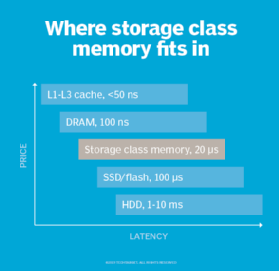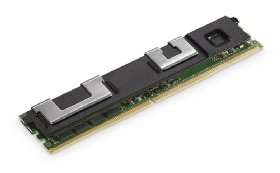
Fotolia
5 storage class memory queries answered
Find out if emerging SCM technology is right for your organization with this look at the benefits, uses and products, as well as what to assess when considering it.
Storage class memory is a new class of non-volatile memory worth paying attention to. It aims to fill the gap between existing storage and memory technologies, bringing together the best of both in a way that could fundamentally change data storage.
On one end, dynamic RAM, or DRAM, is fast and efficient, but it's expensive, isn't persistent and has scalability limits. On the other end, traditional storage is cheaper, persistent and can handle large amounts of data, but it isn't as fast and doesn't last as long as DRAM.
AI, machine learning and other memory-intensive applications place increased demands on system memory. Storage class memory (SCM) looks like a likely candidate to solve the memory-storage stress, at least for some applications.
What benefits does SCM promise?
Storage class memory is emerging technology that aims to combine the best parts of memory and storage. Persistence is one of SCM's key advantages. Because it can hold on to data throughout a power cycle, it opens the possibility for products that can be used for both memory and storage. Some new versions of SCM are nearly as fast as DRAM and can even scale to greater capacities. And SCM may become cheaper than DRAM once products are in full production mode.
On the storage side, SCM is as much as 10 times faster than NAND flash drives and doesn't face the wear issues of NAND. Another significant advantage SCM has over NAND: It can be addressed at either the byte or the block level, letting OSes and applications directly access bytes while reducing I/O overhead.

SCM has the potential to do away with the memory and storage distinction and offer a single tier that encompasses both. As a result, primary data could be accessed and stored on a single SCM device.
What are some SCM use cases?
Uses for storage class memory are beginning to emerge. On the storage array side, SCM can be deployed as a caching tier for applications that require low latency. On the server-controller side, it can serve as a DRAM alternative, working with CPUs that support SCMs.
Because SCM is less expensive per gigabyte than DRAM, it's increasingly being looked at as a DRAM replacement. It can provide the persistence that DRAM lacks and nearly equivalent performance levels. It's expected to be particularly useful for read-intensive AI and deep data analytics applications. Applications that rely heavily on memory can potentially use SCM as an alternative to horizontal scaling. Longer-term, hypervisors are expected to make SCM available to virtual machines.
Is SCM right for your organization?
Intel and Micron Technology have introduced 3D XPoint, also known as storage class memory SSDs. Benchmarks for the technology show much lower latencies and better IOPS compared with the fastest NVMe flash drives. Large data transfer benchmarks show a 10-times improvement with the SCM drives. And industry experts said the biggest performance improvement has come from the SCM drive's low-write latency compared with NAND flash.
But the price of SCM drives is high -- four to five times higher than the fastest comparable NVMe drives. As a result, from a price/performance vantage, SCM can be a difficult sell for most organizations.
Storage consultant Mark Staimer has recommended looking at the potential returns for specific applications where additional revenue can be generated from the faster response times and lower latencies SCM enables. These above-the-line returns encompass revenue and profits that wouldn't be there otherwise. Applications where this approach can apply involve large data transfers and low read and write latencies.
While price and performance are important, it's also important to look at how SCM could improve productivity, time to market and, ultimately, revenue at an organization.

What SCM products are on the market?
Intel came out with Optane DC persistent memory DIMMs in April 2019. The second generation of Intel's Optane DC SSDs and Micron's first 3D XPoint-based SSD are expected to be generally available in 2020.
Products based on Optane SSDs and memory are in development and already on the market. They include Dell EMC PowerMax SAN arrays, Formulus Black's Forsa software, Hewlett Packard Enterprise 3PAR and Nimble Storage arrays, MemVerge Memory-Converged Infrastructure, NetApp Memory Accelerated Data, Pure Storage FlashArray and Vast Data Universal Storage.
Just what is MRAM?
Another storage class memory technology used to replace DRAM in SSDs with persistent memory is magnetoresistive RAM, or MRAM. Instead of using electrical charges to store data bits, as DRAM does, MRAM uses magnetic states. The technology combines the high speed of static RAM with the high density of DRAM, letting it store more data and access it faster, while using less power than electronic memory.
MRAM is starting to appear in the enterprise. IBM uses MRAM in the FlashCore media in its FlashSystem arrays. Applied Materials, Avalanche Technology, Crocus Technology and Spin Memory also have MRAM-based products.








